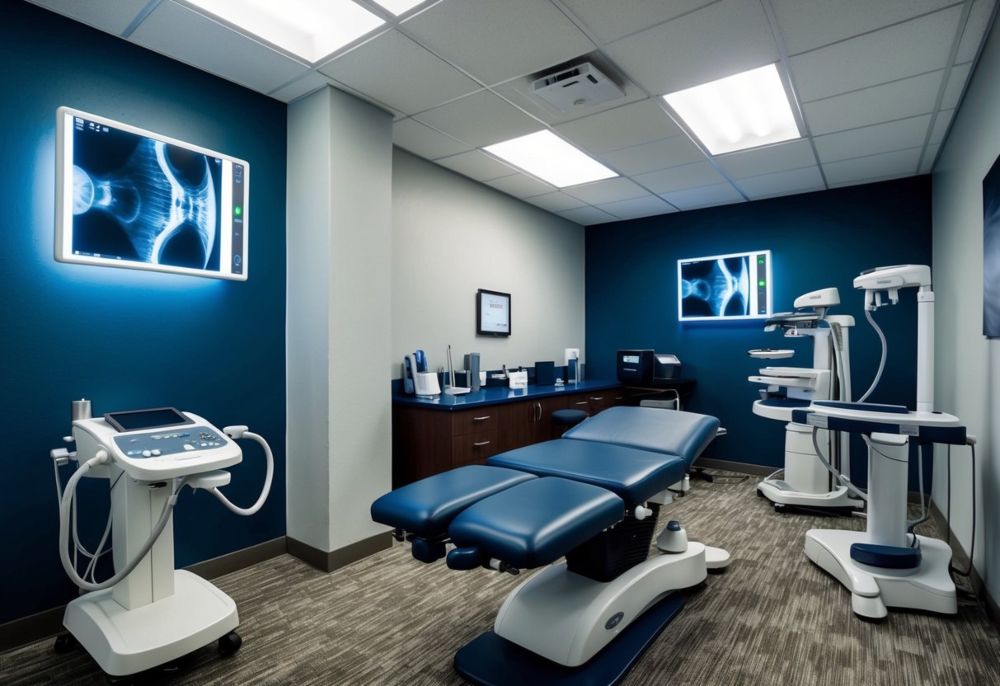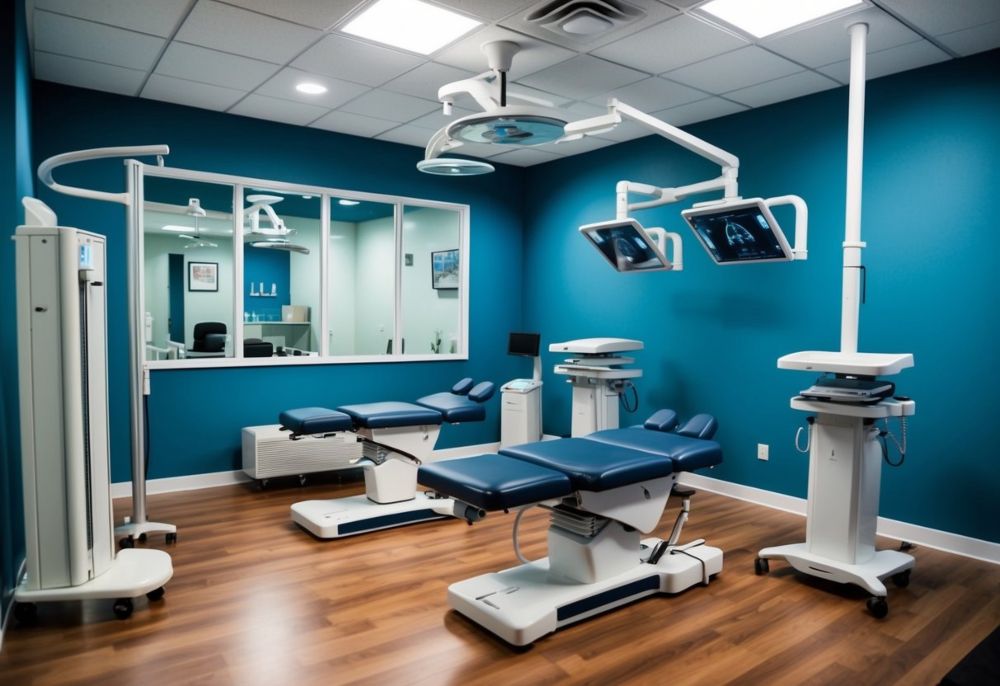

How can chiropractic practices afford the latest equipment to provide the best care without straining their budgets?
Chiropractors face a unique challenge: investing in advanced equipment like adjustment tables, imaging systems, and therapeutic tools is crucial for improving patient care, yet these essentials come with high costs.
Medical equipment financing offers a straightforward solution, allowing chiropractic practices to access cutting-edge technology without draining cash flow or compromising patient outcomes.
Financing chiropractic equipment can help practices expand services, improve patient outcomes, and boost revenue.
With the right financing plan, chiropractors can upgrade their diagnostic and treatment tools without straining their budgets. These include X-ray machines, adjustment tables, and electronic health record systems.
Many financing options are available for chiropractic practices, ranging from traditional bank loans to specialized medical equipment leases.
Each option has its pros and cons, so chiropractors should weigh these carefully to find the best fit for their needs and financial situation.

Financing is crucial in helping chiropractors expand their practices and stay competitive. It allows access to advanced equipment and tools that can improve patient care and attract new clients.
Chiropractors need financing to keep up with the latest advancements in their field. Modern diagnostic tools like X-ray machines are expensive but essential for accurate diagnoses. Without financing, many practices would struggle to afford these items.
Financing also helps chiropractors manage their cash flow. Instead of paying large sums upfront, they can spread the cost over time, leaving more money for other important expenses like staff salaries and marketing.
For new chiropractors, financing can make the difference between starting a practice or not. It provides the funds needed to set up an office and buy initial equipment.
To maintain a competitive edge, chiropractors must invest in specific types of equipment:
These tools help chiropractors provide better care and offer a wider range of services. For example, adding massage therapy can attract new patients and increase revenue.
Advanced diagnostic equipment allows for more precise treatments. This can lead to better patient outcomes and more referrals, driving practice growth.

Chiropractors face distinct obstacles when seeking to finance their specialized equipment. The high costs and unique nature of chiropractic tools create complexities in obtaining and managing financing.
Chiropractic equipment financing often involves substantial investments. X-ray machines, adjustment tables, and advanced diagnostic tools can cost tens of thousands of dollars. This high price tag makes purchasing equipment outright challenging for many practitioners.
Lenders may view chiropractic equipment as niche, potentially affecting loan terms. Interest rates might be higher due to perceived risk. Chiropractors must carefully evaluate financing options to ensure they don’t overextend their budgets.
Some equipment depreciates quickly, impacting its value as collateral. This factor can influence a lender’s willingness to provide favorable terms. Chiropractors need to consider the long-term value of their investments when seeking financing.
Balancing equipment costs with practice growth presents a significant challenge. Chiropractors must weigh the potential return on investment against monthly payments. New equipment can attract patients, but it also increases overhead.
Cash flow management becomes crucial when financing equipment. Practices need to ensure they can meet loan obligations while covering other expenses. This balancing act requires careful financial planning and forecasting.
Financing chiropractic equipment may limit funds available for other growth initiatives. Chiropractors must prioritize which equipment will provide the best value for their practice and patients. They should consider leasing options for flexibility in upgrading as technology advances.
Chiropractors can finance various tools to enhance patient care and practice efficiency. Modern equipment improves diagnostic capabilities, treatment outcomes, and overall patient satisfaction.
Chiropractic adjustment tables are essential for performing spinal manipulations. These tables come in different styles, including stationary, portable, and drop tables.
Digital x-ray machines allow for quick and accurate imaging of patients’ spinal health. They provide clear images for precise diagnoses.
Therapeutic equipment, such as laser therapy devices, can help reduce pain and inflammation. These tools offer noninvasive treatment options for various conditions.
Rehabilitation equipment such as exercise balls and resistance bands aid in patient recovery. They help improve strength and flexibility during the healing process.
Electronic health record (EHR) systems streamline patient management and improve workflow. They allow for easy access to patient histories and treatment plans.
Diagnostic tools like surface electromyography (sEMG) devices measure muscle activity. This technology helps identify areas of tension or weakness in patients.
Patient education software can improve understanding of chiropractic care. It uses visual aids to explain treatments and spinal health concepts.
Scheduling software helps manage appointments and reduces wait times. This improves the patient experience and practice efficiency.
Investing in cutting-edge chiropractic technology can lead to better patient outcomes. Advanced tools allow for more precise diagnoses and targeted treatments.
Modern equipment often improves the efficiency of chiropractic practices. It can speed up processes and allow chiropractors to see more patients.
New technology can expand a practice’s service offerings, attracting new patients and keeping existing ones engaged in their care.
Up-to-date equipment can boost a practice’s reputation. Patients often view practices with modern tools as more professional and capable.
Stay ahead in chiropractic care with flexible funding. Small Business Assets & Capital Equipment Loans let you acquire high-quality tools and diagnostic systems tailored to your needs. Get the support you need to elevate patient outcomes without financial strain.
If you’re ready to get started, call us now!
Chiropractors have several options to fund new equipment purchases. These choices can help practices grow without draining cash reserves. Each option has its own benefits and drawbacks.
Short-term loans offer quick funding but have higher monthly payments. They work well for smaller purchases or when cash flow is strong. Long-term loans spread costs over more time, making monthly payments lower and easier to manage.
Equipment loans often have fixed interest rates, which helps with budget planning. Some lenders offer no down payment options, which preserves cash for other needs.
Long-term loans may have lower interest rates but can cost more over time due to interest. Short-term loans may have higher rates but less total interest paid.
Lines of credit give chiropractors flexible funding. They can borrow and repay as needed. This works well for ongoing equipment needs or unexpected purchases.
Interest is only paid on the amount used, which can save money compared to a full loan. Credit lines can be revolving, meaning funds become available again after repayment.
Some lenders offer specialized credit lines for medical equipment. These may have better terms than general business lines and be faster to set up than traditional loans.
Leasing lets chiropractors use new equipment without buying it outright, preserving cash for other business needs. Monthly payments are often lower than loan payments.
Many leases include maintenance and upgrades. This can reduce overall costs and keep equipment current. Some leases offer purchase options at the end of the term.
Leasing can provide tax benefits, as payments may be fully deductible as business expenses. This differs from depreciation rules for purchased equipment.
Vendor financing is another leasing option. Equipment makers may offer competitive rates and terms, which can streamline the process of getting new tools.
Leasing medical equipment offers chiropractors several key benefits. It can help manage costs, provide tax advantages, and allow access to the latest technology. Let’s explore the main advantages in more detail.
Equipment leasing allows chiropractors to acquire necessary tools without large initial investments. This frees up cash for other business needs.
Leasing allows chiropractors to upgrade equipment as technology advances. At the end of lease terms, they can easily switch to newer models.
Monthly lease payments are often lower than loan payments for purchasing equipment outright, improving the practice’s cash flow.
Leasing companies typically handle maintenance and repairs. This reduces unexpected costs and downtime for the chiropractor.
Lease payments can usually be deducted as business expenses. This lowers the chiropractor’s taxable income each year.
Section 179 deductions may apply to leased equipment. They allow chiropractors to deduct the full cost of qualifying equipment in the year it is put into service.
Leasing can help chiropractors avoid the alternative minimum tax in some cases. This is because leased equipment isn’t considered an asset for AMT purposes.
Proper documentation of leased equipment use is important. It helps maximize available tax benefits and deductions.
Purchasing equipment can be wise for items used frequently over many years. The long-term cost of ownership may be lower than leasing in these cases.
Buying makes sense for basic, durable equipment that doesn’t require frequent upgrades. Examples include adjustment tables or x-ray machines.
Ownership allows chiropractors to build equity in their equipment. They can sell it later if needed or use it as collateral for loans.
Purchasing may offer more customization options. Chiropractors can modify owned equipment to suit their specific needs and preferences.
Getting financing for chiropractic equipment involves several steps. Chiropractors must gather documents, understand loan terms, and know what to expect during approval.
Chiropractors need specific documents for equipment financing. These often include:
Keep these records up-to-date to speed up the process. Create a digital folder with all the needed files. This makes it easy to submit quickly when applying.
Some lenders offer online applications for faster processing. Fill out forms carefully to avoid delays, and double-check all information before submitting.
If you’re ready to get started, call us now!
Loan terms vary based on the lender and the chiropractor’s financial situation. Common options include:
Repayment periods can range from 1 to 7 years. Longer terms mean lower monthly payments but more interest paid overall.
Interest rates depend on creditworthiness. Chiropractors with good credit scores often get better rates. Some lenders offer options to defer payments or make interest-only payments at first.
It’s crucial to read the fine print. Look for any prepayment penalties or balloon payments.
The approval timeline for chiropractic equipment financing can vary. Simple applications might be approved in 1-2 days. More complex requests can take 1-2 weeks.
Tips for faster approval:
Online lenders often have faster turnaround times than traditional banks. Some offer pre-approval in minutes. This can speed up the equipment purchase process.
Keep in touch with the lender throughout the process. Ask for updates if you haven’t heard back in a few days.
SBAC Funding offers chiropractors many advantages when financing equipment. Their options help practices grow, build equity, and access working capital. Let’s look at the key benefits.
SBAC Funding creates tailored financing plans for each chiropractic practice. They offer loans with flexible terms to match cash flow needs, and chiropractors can choose from various repayment schedules.
Some options include:
This flexibility helps practices manage expenses. It allows for equipment upgrades without hurting day-to-day operations. Chiropractors can preserve working capital for other needs.
SBAC Funding provides quick approvals for equipment loans. Many chiropractors get funds in just a few days. This speed lets practices seize opportunities fast.
Their competitive rates make financing affordable. Lower costs mean practices can invest in high-quality equipment. Some benefits include:
Fast, affordable financing helps practices grow without cash flow issues.
SBAC Funding backs practice growth plans. Their loans help chiropractors expand services and treat more patients. Practices can finance multiple pieces of equipment at once.
This support enables:
Improved equipment means better patient care. It can attract new clients and boost practice revenue. SBAC Funding becomes a partner in the practice’s long-term success.
Upgrade your chiropractic practice without breaking the bank. Small Business Assets & Capital’s Medical Equipment Financing options let you affordably access advanced tools like adjustment tables and imaging systems. Begin expanding your services. Contact us now.
Managing financed equipment effectively is key for chiropractors to maximize their investment and practice growth. Here are some practical tips to help optimize equipment use and financial management.
Creating a solid budget is crucial for managing loan repayments. Chiropractors should track monthly revenue and expenses carefully. This helps ensure timely payments and avoids cash flow issues.
Set aside a fixed percentage of monthly income for loan payments. This can help maintain consistent repayment even during slower months.
When budgeting, consider seasonal fluctuations in patient volume. Plan for higher payments during busier periods to offset leaner times.
Consult with a tax professional to understand potential tax deductions related to equipment financing. This can impact overall budget planning.
Use accounting software to track payments and forecast future expenses. This helps chiropractors stay on top of their financial obligations.
Anticipating future needs is essential for long-term practice growth. Chiropractors should regularly assess their equipment and practice goals.
Create a 3-5 year plan for potential upgrades or new equipment purchases. This allows for better financial preparation and timing of investments.
Research emerging technologies in chiropractic care. Stay informed about advancements that could benefit patients and improve practice efficiency.
Build a savings fund for future equipment purchases. Setting aside a portion of monthly revenue can ease the financial burden of upgrades.
Consider flexible financing options for future expansions. This may include lines of credit or lease-to-own agreements for equipment.
Involve staff in discussions about equipment needs. Their input can provide valuable insights into the tools most benefit patient care.
Measuring return on investment (ROI) is critical for evaluating the impact of financed equipment. Chiropractors should implement systems to track both financial and clinical outcomes.
Use practice management software to monitor patient volume and revenue changes after equipment acquisition. This data helps quantify financial ROI.
Implement patient surveys to gather feedback on new treatments or equipment. This provides insights into patient satisfaction and outcomes.
Track specific metrics related to each piece of equipment. For example, monitor treatment times, patient recovery rates, or repeat visit frequency.
Analyze billing data to identify changes in reimbursement rates or new billable services. This can highlight the financial impact of equipment investments.
Review and compare equipment performance regularly against initial projections. This helps identify any needed adjustments in usage or marketing strategies.
Financing medical equipment enables chiropractors to access advanced tools and grow their practices. The right approach can boost patient care and financial success. Smart investments in equipment often lead to long-term practice growth.
Choosing the best financing partner is key for chiropractic practices. Look for lenders who understand healthcare providers’ unique needs. They should offer flexible terms and competitive rates.
A good partner will help you navigate different financing options. These may include traditional bank loans, equipment leases, or specialized healthcare lenders. Each option has pros and cons.
Compare interest rates, repayment terms, and any fees. Ask about early payoff options and potential tax benefits. The right partner will guide you through the process and help you make informed decisions.
Modern equipment can also streamline operations. It may reduce treatment times or allow more patients to be seen, which can boost the practice’s revenue and profitability over time.
Ready to invest in your practice’s growth? Small Business Assets & Capital offers customized Medical Equipment Leasing to help chiropractors secure top-tier technology while keeping cash flow intact. Take the next step in practice excellence—start your financing journey with us today!
What financing options are available for purchasing chiropractic equipment?
Chiropractors can choose from several financing options. Traditional bank loans offer fixed interest rates and structured repayment terms.
Equipment leasing allows practitioners to use equipment without full ownership. Some companies offer specialized chiropractic equipment financing with tailored terms for the industry.
How can a chiropractor qualify for medical equipment financing?
Chiropractors typically need a good credit score and a stable practice history to qualify. Lenders may review business financials, including revenue and cash flow.
New practices might need to provide a strong business plan. Some lenders may require collateral or a personal guarantee from the chiropractor.
What are the benefits of financing chiropractic tools versus paying cash?
Financing preserves cash flow, allowing chiropractors to keep money for other business needs. It enables access to advanced equipment that might be too costly to purchase outright.
Financing can offer tax benefits, as payments may be tax-deductible. It also allows chiropractors to upgrade equipment more frequently, staying current with technological advances.
What criteria do financiers consider when providing funds for chiropractic equipment?
Financiers assess the equipment’s value and useful life by looking at the chiropractor’s credit history and the practice’s financial health.
Key factors are the practice’s revenue and profitability. Lenders may also consider the chiropractor’s experience and the practice’s location.
Can startup chiropractic practices obtain financing for equipment?
Yes, startup practices can obtain financing, but it may be more challenging. New chiropractors might need to provide a detailed business plan and financial projections.
Personal credit scores have become more important for startups. Some lenders offer special programs for new practices, and equipment leasing can be viable.
What types of chiropractic equipment are commonly financed?
Due to their high cost, X-ray machines are frequently financed. Adjusting tables, electrotherapy devices, and diagnostic tools are also common items.
Advanced technology, such as spinal decompression machines and laser therapy equipment, is often financed. Office equipment and software systems may also be included in financing packages.